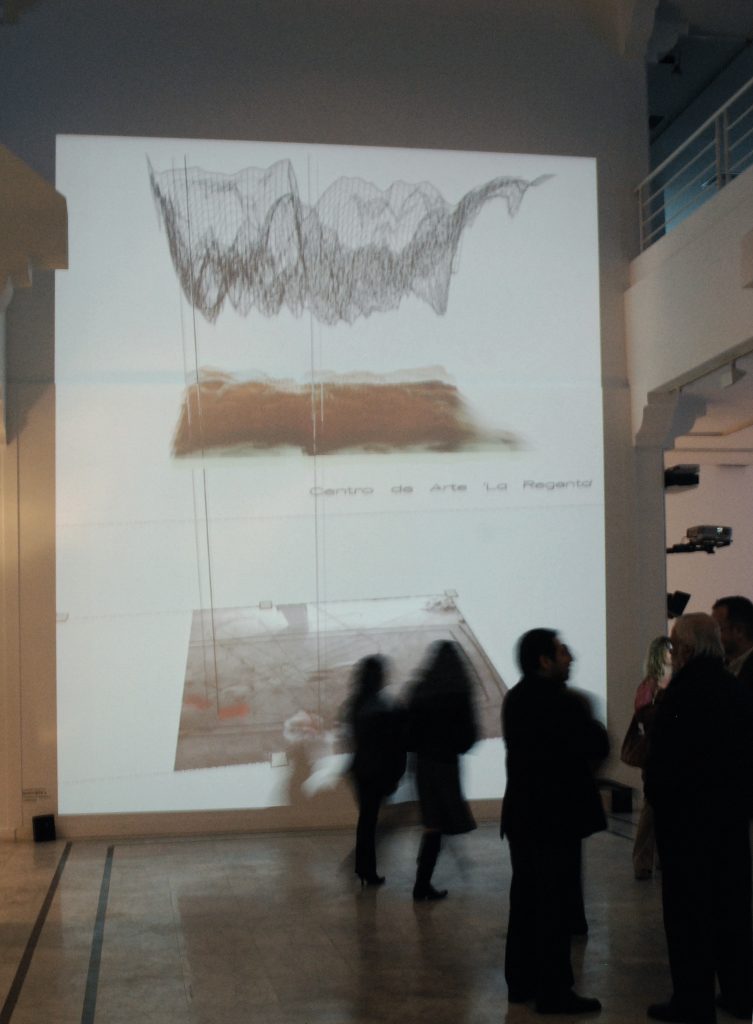
Inoutsite I und II zeigen die Statistik der Raumnutzung.
Nach 1989 entstand aus früheren skulpturalen Arbeiten eine Serie von Zeichnungen geometrischer Muster, die als mathematische Beschreibungen des Raumes zu verstehen sind. Der Raum wurde in seinen proportionalen Rhythmen von endlichen und unendlichen Dimensionen und Rekursionen dekliniert. Die entstandenen Musterzeichnungen sind ein Formenkanon, der als Grundlage für eine großräumige Stadtplanung gedacht ist: Die Polymorphie der Muster ermöglicht es, einzelne Elemente in bereits vorhandene Proportionen einzufügen und aus dem bereits vorhandenen „Alten“ eine berechnete Beschreibung des „Neuen“ zu generieren. Das Ergebnis dieser Berechnungen war ein Set geometrischer Grundformen mit Fernwirkung, das die Grundlage für die erste interaktive Installation „trace pattern“ bildet. In dieser Installation werden Muster automatisch berechnet und mit der Bewegung von Menschen, die sich in einem bestimmten Raum bewegen, verknüpft, wobei die daraus resultierenden Proportionen untersucht werden können
Für „inoutsite“ (siehe auch http://www.inoutsite.de) wurde eine Tracking-Software speziell für die Überwachung von öffentlichen Räumen entwickelt (Programmautoren: Thomas Kulessa und Matthias Weber). Diese Erfahrung mit der maschinellen Verarbeitung von Bewegungsspuren führte zu einer allmählichen Verlagerung des Arbeitsschwerpunktes – von der Konstruktion von Beschreibungsmodellen hin zur Beobachtung von Bewegungen. In der Installation des „inoutsite“-Projekts wurde die Häufigkeit der Besuche des überwachten Ortes analysiert und in Bild und Ton umgesetzt, die daraus resultierenden virtuellen dreidimensionalen Formen können als erste virtuelle Architektur betrachtet werden.

Die roten Pfeile zeigen in die Richtung des Gehens, die Linien sind die Spuren der Menschen im Raum. Die Höhe des Netzes, das wie ein virtuelles Dach über der Beobachtungsfläche schwebt, zeigt die Häufigkeit, mit welcher ein Ort begangen wird.Umso mehr Leute an einem Ort stehen, umso tiefer sinkt das Netz. Die Wolke in der Mitte zeigt dieselbe Information wie das Netz, differenziert nach Intensitätsgraden. Klänge fungieren als „Monitor“ der Besucherbewegung: tiefe Töne stehen für Randpositionen, hohe Töne für die Mitte des Raumes.
Sculpting the clouds (a Text by Katja Davar)
Ursula Damm navigates spaces. As long as I have known her this has been her main occupation in
one form or another. I recall her gait at the Art Academy in Düsseldorf that I watched from a
distance and even then it struck me that the person coming towards me was somehow navigating
the space of that long, endless corridor in a different and definitely less earth-bound way than
many. Looking at her artwork over the past years, the spatial aspect has always dominated in
some form and her ability to turn what could almost be termed a scientific research project into
something visually exciting is for me the core of the work. Assuming that Ursula Damm could
just as easily have found her way into pure science, the respect that her work commands is one
quite different to the subjectivity often associated with an artistic production. From her sculptural
roots that moved into a virtual space, to dynamic architectural arenas and the visualisation of
human movement – if one were to analyse the movement through the work as one that is physical,
perhaps one could say that the camera perspective (angle) has constantly increased until, as in the
most recent works, one has a bird’s eye view of her production. Ursula Damm’s interest in the
interior and exterior, i.e. programming and interface, or re/search and re/sult, or even local and
global leads me to believe that she is in a strange way attempting to leave a particular state of
being in order to discover another. Could this be the age-old desire to fly? To view the world at
an angle known only to birds and the wind? Increasingly the works have a real oddness about
them, they defy categorisation, which naturally makes them troublesome, as the viewer has to
weave an individual vocabulary in order to assess them.
Ursula Damm embraces a multi-tiered approach not only through the utilisation of images formed
partly through technology, but also through the usage of waste-products – possibly the stuff from
which science is made – and lastly her passion for the interactive about which we have argued
many a time!
The complex reflection on an analogy between space, time, the human and flight all find expression
in the work of Ursula Damm, perhaps the question is not when will the clouds be sculpted
but from whom.
Katja Davar